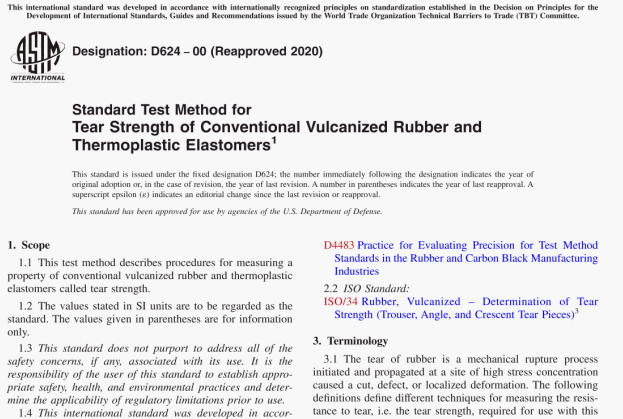ASTM D624:20 pdf download.Standard Test Method for Tear Strength of Conventional Vulcanized Rubber and Thermoplastic Elastomers.
7. Test Piece Preparation
7.1 Cut test pieces shall be obtained from molded test specimen sheets. Compression molded test specimen sheets shall use molds conforming to Practice D3182. Molded test specimen sheets may also he prepared by injection molding into plaques. For test pieces cut from products, Practice D3 183 shall be followed.
7.1.1 Molded test specimen sheets shall be 2.3 ± 1.0 mm (0.09 ± 0.04 in.) thick with the milling grain or flow direction clearly marked.
7.1.2 Injection molded test specimen sheets may not have the same degree of anisotropy as compression molded sheets, and this may affect the tear test results. In injection molded sheets, the grain direction is parallel to the flow direction.
7.1 .3 Anisotropy may also affect results for test pieces cut from products. A record of the orientation of cut test pieces shall also be made in these cases.
7.2 Molded test pieces are molded in shapes defined by the specifications in Fig. 1, Fig. 2 or Fig. 3. Molded test pieces may produce different results from cut test pieces.
7.3 The usual practice is to test with the grain running the length of the test piece. For Type A, B and C test pieces, the tear would thus be recorded as across the grain. It is to be assumed, unless otherwise specified, that all Type A. B or C test pieces are prepared in this manner. Type T and CP test pieces are also prepared with the grain running parallel to the length. This means that for Type T and CP tests the tear will he parallel to the grain. Where grain effects are significant and are to be evaluated, an additional set of test pieces shall be prepared with the grain running across the length. Results so obtained shall he recorded as with the grain for Type A, B or C tests and across the grain for Type T and CP tests.
7.4 Using the cutting die for the desired test type, cut the test pieces from the sheet with a single impact stroke (by hand or machine) to ensure smooth cut surfaces.
7.5 For Type A and B test pieces, nick the test piece using the nicking device described in 6.5.1. Wet the blade with water or soap solution prior to nicking the test piece. Nick the test piece to a depth of 0.50 ± 0.05 mm (0.020 ± 0.002 in.) with a single stroke of the blade. If a nicking die is used, the nick is formed when the test piece is cut from the sheet.
7.5.1 To assure a proper cut with the nicking device, one or two preliminary nicks shall be made on extra test pieces and the depth of the cut checked using a microscope with a minimum of lOx magnification.
7.6 For Type T and CP test pieces. an initial cut should be made with a razor blade or sharp knife. The last 1 mm (approximately) of the cut shall be made with a single stroke.
7.6.1 Type T test pieces shall have an initial cut of 40 ± 5 mm as shown in Fig. 2.
7.6.2 Type CP test pieces shall have an initial cut of 60 ± 5 mm made down the groove between the two legs.
7.7 Three test pieces per sample shall be tested for tear strength, and the median value of the test pieces reported as a test result.
ASTM D624:20 pdf download
